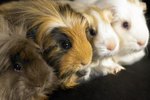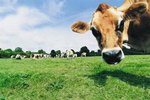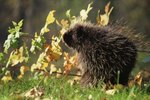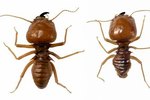
Honey locusts (Gleditsia triacanthos) are mid-sized trees that develop rapidly and are seen in many parts of North America, from Ontario to Florida. Although North America is their homeland, they're also seen in other parts of the world, including Australia. A wide array of different animals routinely feed on the sizable fruit pods that honey locusts produce.
Pod Diners
Honey locust pods fall in the autumn. They rely on a variety of animals to open their pods, as they don't do so on their own. Many wild animals feed on honey locust pods. At the same time, they're also common food staples for various kinds of farm animals. Animals dine on the pods and seeds, then in turn distribute the seeds.
Wild Animals
Some of the many wild animals that dine on honey locust pods are Virginia opossums (Didelphis virginiana), American crows (Corvus brachyrhynchos), white-tailed deer (Odocoileus virginianus), starlings (family Sturnidae), eastern cottontail rabbits (Sylvilagus floridanus) and northern bobwhite birds (Colinus virginianus). Many foxes and squirrels also munch on honey locust pods.
Farm Animals
The various domesticated animals that eat honey locust pods are pigs, goats, sheep, cattle and horses. The fruits of honey locusts are thought to provide some nutritional value to certain animals, including cattle. They contain lots of protein, which is beneficial for them.
Seed Characteristics
The outer portions of honey locust seeds have extremely tough textures that are essentially impossible to filter through. The seeds are only capable of germination once they've passed through a consumer's digestive tract, making them pervious. Despite this, not all creatures are capable of digesting them. As far as appearances go, honey locust pods typically grow to between 6 and 8 inches in length, with reddish-brown coloration. They consist of plentiful glossy, deep brown seeds. The seeds are usually about one-third of an inch in length.
Other Parts of the Trees
Consumption of honey locusts isn't limited to pods and seeds. During the winter months, youthful white-tailed deer often tear off and feed on the smooth bark of these trees. Rabbits also eat the bark by nibbling on it. Some insects feed on the foliage of the trees, too -- namely both whitemarked tussock moths and spider mites.
References
- VirginiaTech Forest Resources and Environmental Conservation: Honey Locust
- Purdue University Extension: Honey Locust
- The Teaching Gardens of Saint Michael's College: Honey Locust
- Brisbane City Council: Honey Locust
- US Forest Service: Gleditsia Triacanthos
- Indiana Native Plant & Wildflower Society: Honey Locust
Photo Credits
-
Comstock/Stockbyte/Getty Images




